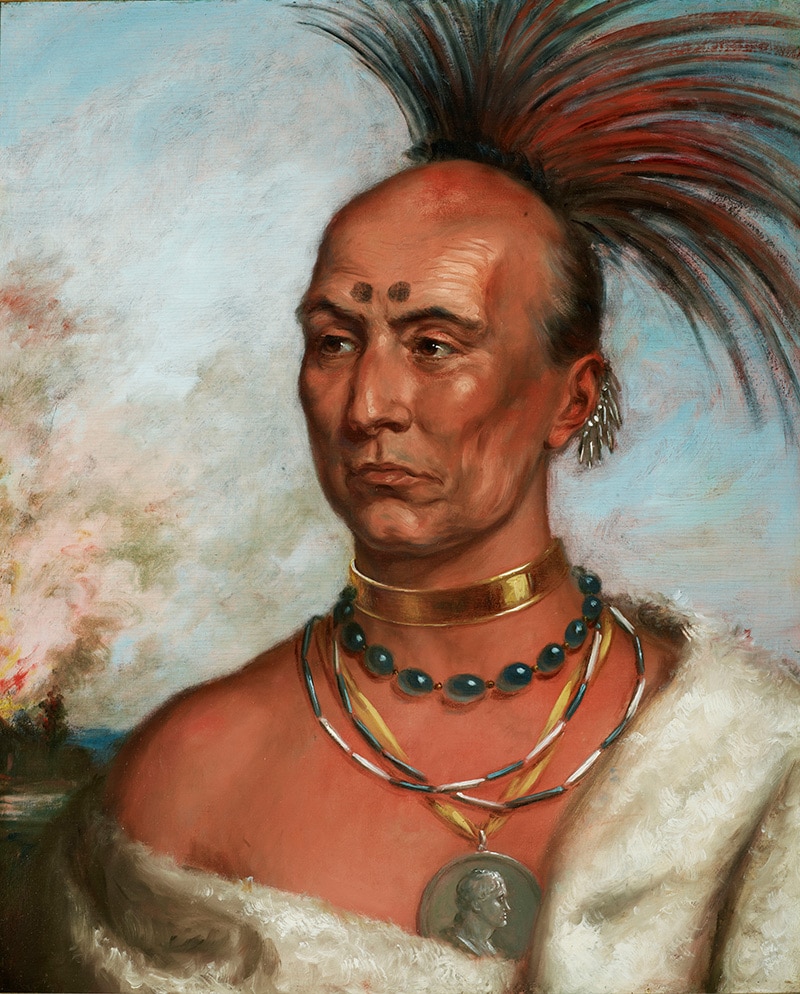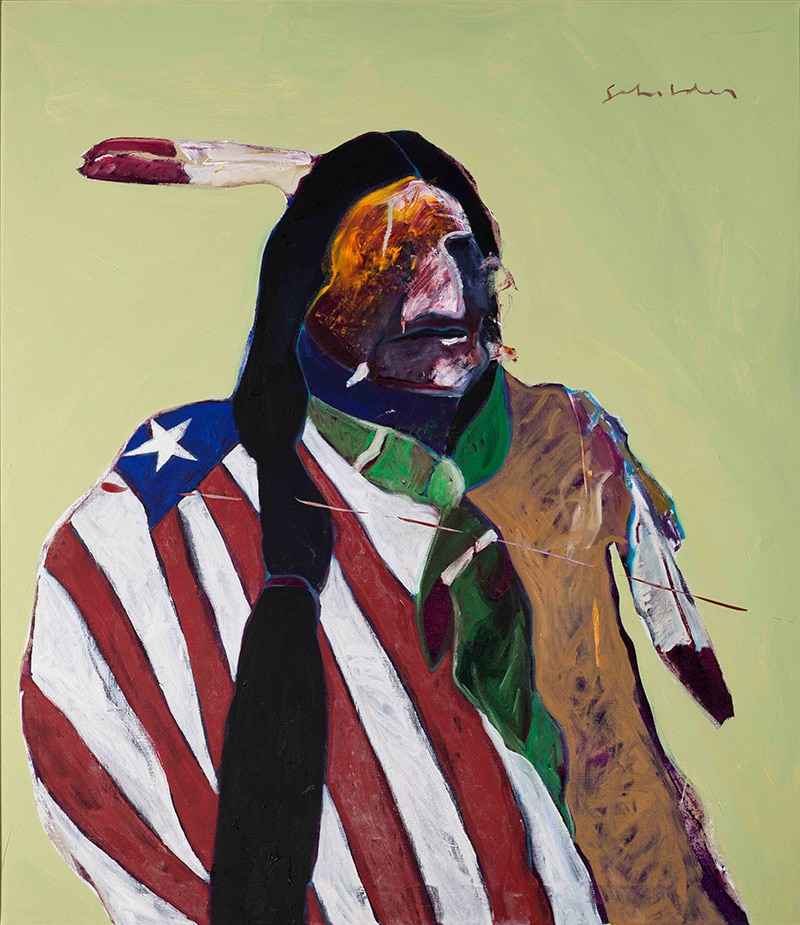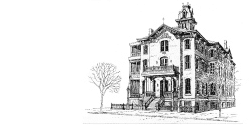Portraits as Primary Sources
Charles Bird King, Black Hawk, Makataimehikiakiah, c. 1833.
Fritz Scholder, An American Portrait, 1979.
Background Information
Portraiture was already a well-established European art form by the time settlers arrived in America. Photography wasn’t widely available as a technology until the last half of the 19thcentury so painted portraits were one of the earliest ways settlers documented the people they encountered when they arrived in the West. However, by looking closely at the details in each painting, we can see more than just what someone looked like. Portraits can indicate power, importance, virtue, beauty, wealth, taste, learning, or other attributes of the sitter.
The details, or visual clues, present in portraits can be seen as evidence of facts in your research. A primary source provides direct or firsthand evidence about an event, object, or person, whereas a secondary source was likely produced sometime after an event happened, so it has greater potential to show bias or opinion. We can use critical thinking skills to ask a lot of questions and uncover the clues in each portrait we look at.
Look Closer

Notice details in the painting to identify the individual, including clothing and accessories (robe over shoulders),
jewelry,
feather headdress,
and face paint which signifies his particular clan membership within the Sauk tribe.
He wears an Indian Peace Medal around his neck.
Look especially closely along the horizon line, behind Blackhawk’s right shoulder.
Notice that the expression on his face demonstrates wary determination with a set jawline and slightly downturned lips.
Charles Bird King, Black Hawk, Makataimehikiakiah, c. 1833.
Notice details in the painting to identify the individual, including clothing and accessories (robe over shoulders1, jewelry2, feather headdress3, and face paint which signifies his particular clan membership within the Sauk tribe4). He wears an Indian Peace Medal around his neck5. What is happening in the background of the painting? Look especially closely along the horizon line, behind Blackhawk’s right shoulder6. Notice that the expression on his face demonstrates wary determination with a set jawline and slightly downturned lips7.

Notice details in the painting to identify the individual including feathers here.
Notice details in the painting to identify the individual including feathers here.
as well as the leather or fringe,
and a ponytail, braid or long hair.
The sitter is wearing a kerchief or bandana
and an American Flag.
Observe that the artist has simplified the background
and painted a pink slash mark through the middle of the figure which further obscures his/her identity.
Fritz Scholder, An American Portrait, 1979.
Notice details in the painting to identify the individual including feathers1 2, leather or fringe3, and a ponytail, braid or long hair4. The sitter is wearing a kerchief or bandana5 and an American flag6. Can you discern the person’s facial expression or mood? Observe that the artist has simplified the background7 and painted a pink slash mark through the middle of the figure8, which further obscures his/her identity.
Activity
Take at least ten minutes to look at and list the visual clues in each painting. Make use of the primary source analysis graphic organizer/worksheet (available for both elementary and secondary grade levels) below to help encourage a lengthy list of details.
LOC Primary Source Analysis Tool
CDE Elementary Primary Source Artwork Analysis Tool
Tools like these worksheets help us organize our thoughts before we jump to conclusions about who the sitter is, why they are wearing certain articles, or what their facial expressions are telling us. If we go step by step, we’ll have enough evidence to support our conclusion.
Take some time to reflect on the evidence you’ve listed on your worksheet. This can be done individually and then shared with the group, or it can be done as a group discussion. What is your hypothesis? For example, if the individual is wearing organic materials or a headdress, are they indigenous? Or, if one wears an American flag, are they American? Once you have formed your group or individual hypotheses, take time to discuss the questions that still remain.
Is your group absolutely certain of these individuals’ identities? List all of the questions you would like answers to using the worksheet. For example, “Who is this portrait of?” “Why did the artist paint this person?” “Who was the artist, and how did that impact his/her decision to paint the person?” “Who bought the painting once it was created?”
Encourage students to perform additional research to find answers to their questions. We have included a list of resources to help below.
Charles Bird King Background Information
Fritz Schilder Background Information
https://americanart.si.edu/artist/charles-bird-king-2628
http://www.gutenberg.org/files/7097/7097-h/7097-h.htm
http://denverartmuseum.org/article/dams-new-exhibition-highlights-native-artist-fritz-scholder
http://www.artcyclopedia.com/feature-indian-not-indian.html
Grade levels: P-12 CO Standards
Visual Arts (2020)
Preschool: 1.1 ; 2.1 ; 4.1
Kindergarten: 1.1 ; 2.1 ; 3.1 ; 4.1
1st Grade: 1.1 ; 2.1 ; 4.1
2nd Grade: 1.1 ; 4.1
3rd Grade: 1.1 ; 2.1 ; 4.1-2
4th Grade: 1.1-2 ; 2.1 ; 4.1-2
5th Grade: 1.1-2 ; 2.1 ; 4.1
6th Grade: 1.1-3 ; 2.1-2 ; 4.1-2
7th Grade: 1.1-3 ; 2.1-2 ; 4.1-2
8th Grade: 1.1-2 ; 2.1-2 ; 4.1-3
High School: 1.1-2 ; 2.1-2 ; 4.1-3
Social Studies (2020)
Preschool: 1.1 ; 2.1 ; 4.1
Kindergarten: 1.1-2 ; 2.2
1st Grade: 1.1-2 ; 2.2 ; 4.1-2
2nd Grade: 1.1-2 ; 2.2 ; 4.2
3rd Grade: 1.1-2 ; 2.2 ; 4.1
4th Grade: 1.1-2 ; 2.2 ; 3.1 ; 4.1
5th Grade: 1.1-2 ; 2.2 ; 4.1
6th Grade: 1.1-2 ; 2.2 ; 3.1 ; 4.1-2
7th Grade: 1.1
8th Grade: 1.1-2 ; 2.1-2 ; 4.1
High School: 1.1-3 ; 2.2-3
Reading, Writing and Communicating (2020)
Preschool: 1.1-2 ; 2.1 ; 3.1 ; 4.1
Kindergarten: 1.1-2 ; 2.2-3 ; 3.1-4 ; 4.1
1st Grade: 1.1-2; 2.2-3 ; 3.1-4 ; 4.1
2nd Grade: 1.1-2 ; 2.1-2 ; 3.1-3 ; 4.1
3rd Grade: 1.1-2 ; 2.2-3 ; 3.1,3-4 ; 4.1
4th Grade: 1.1-2 ; 2.2-3 ; 3.1-4 ; 4.1
5th Grade: 1.1-2 ; 2.2-3 ; 3.1-4 ; 4.1
6th Grade: 1.1-2 ; 2.2-3 ; 3.1-2,4 ; 4.1
7th Grade: 1.1-2 ; 2.2-3 ; 3.1-2,4 ; 4.1
8th Grade: 1.1-2 ; 2.2-3 ; 3.1-2 ; 4.1
9th/10th Grade: 1.1-2 ; 2.3 ; 3.1 ; 4.1
11th/12th Grade: 1.1-2 ; 2.3 ; 3.1 ; 4.1
Resources
Tate Museum of Art, Portrait:
https://www.tate.org.uk/art/art-terms/p/portrait
Library of Congress, Reading Portraits: Analyzing Art as a Primary Source, by Danna Bell:
https://blogs.loc.gov/teachers/2016/03/reading-portraits-analyzing-art-as-a-primary-source/
Identifying Primary and Secondary Sources, University of Indiana Libraries:
https://libraries.indiana.edu/identifying-primary-and-secondary-sources



